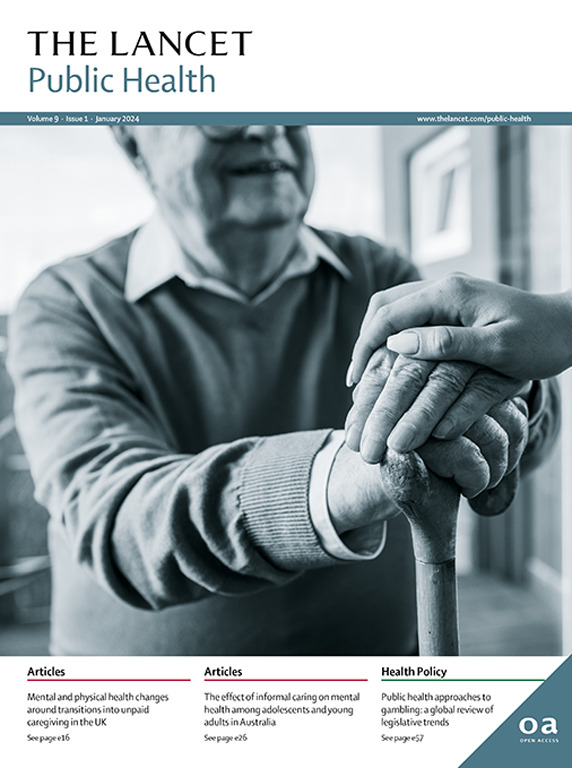Rates, causes, and risk factors for death among justice-involved young people in Australia: a retrospective, population-based data linkage study
IF 25.4
1区 医学
Q1 PUBLIC, ENVIRONMENTAL & OCCUPATIONAL HEALTH
引用次数: 0
Abstract
Background
Children and adolescents exposed to the youth justice system have poor health profiles, but little is known about their subsequent mortality. We aimed to examine mortality outcomes in a large, state-wide cohort of young people in Australia who had contact with the youth justice system.Methods
We linked youth justice records in the state of Queensland, Australia from July 1, 1993, to June 30, 2014, with adult correctional records and the National Death Index, for records up to Jan 31, 2017. We calculated all-cause and cause-specific crude mortality rates per 100 000 person-years, and age-standardised and sex-standardised mortality ratios with 95% CIs. Calculations were performed for the whole cohort and in subgroups defined by sex, Indigenous status, and youth justice history. We used survival analysis to identify demographic and criminal justice factors associated with all-cause mortality.Findings
Of 49 011 individuals in the study sample, 321 were excluded due to data linkage or data quality issues and 20 were excluded as they did not have an age or date of birth recorded, which resulted in 48 670 (99·3%) participants. 11 897 (24·4%) participants were female, 36 773 (75·6%) were male, and 13 250 (27·2%) were Indigenous. During a median of 13·5 years (IQR 8·4–18·4) of follow-up, we observed 1431 (2·9%) deaths among the 48 670 participants. Median age at end of follow-up was 28·6 years (IQR 23·6–33·6). The most common causes of death were suicide (495 [34·6%]), transport accidents (244 [17·1%]), and accidental drug poisoning (209 [14·6%]). The all-cause crude mortality rate was 218·9 deaths (95% CI 207·9–230·6) and the all-cause standard mortality ratio was 4·2 (3·9–4·4). In multivariable analyses, mortality rates were higher for males (adjusted hazard ratio [aHR] 1·5 [95% CI 1·3–1·7]); those who had been subject to community supervision (aHR 1·3 [1·1–1·5]), or detention (aHR 2·1 [1·8–2·4]) versus charge only; and those under adult correctional supervision in the community (aHR 1·9 [1·5–2·4]) versus unsupervised. More than half of the observed deaths occurred before 25 years of age, and very few (1·6%) occurred in custody.Interpretation
Justice-involved young people are at markedly increased risk of premature death from largely preventable causes. Reducing the burden of preventable death among these young people will require coordinated, multi-sectoral responses that extend beyond the criminal justice system.Funding
National Health and Medical Research Council, Australia.澳大利亚参与司法的年轻人死亡率、原因和死亡风险因素:一项基于人群的回顾性数据关联研究
接触青少年司法系统的儿童和青少年健康状况不佳,但对其随后的死亡率知之甚少。我们的目的是在澳大利亚与青少年司法系统有联系的一个大型的、全州范围的年轻人队列中检查死亡率结果。方法将澳大利亚昆士兰州1993年7月1日至2014年6月30日的青少年司法记录与截至2017年1月31日的成人惩教记录和国家死亡指数相关联。我们计算了每10万人年的全因和特定原因的粗死亡率,以及95% ci的年龄标准化和性别标准化死亡率。对整个队列和按性别、土著地位和青少年司法史定义的亚组进行计算。我们使用生存分析来确定与全因死亡率相关的人口统计学和刑事司法因素。在49 011例研究样本中,321例因数据链接或数据质量问题被排除,20例因未记录年龄或出生日期而被排除,共48 670例(99.3%)参与者。女性11897人(24.4%),男性36773人(75.6%),原住民13250人(27.2%)。在中位13.5年(IQR 8.4 - 18.4)的随访期间,我们观察到48670名参与者中有1431人(2.9%)死亡。随访结束时的中位年龄为28.6岁(IQR为23.6 ~ 33.6)。最常见的死亡原因是自杀(495例[34.6%])、交通事故(244例[17.1%])和意外药物中毒(209例[14.6%])。全因粗死亡率为218·9例(95% CI为207·9 ~ 230·6),全因标准死亡率为4.2(3.9 ~ 4.4)。在多变量分析中,男性的死亡率更高(校正风险比[aHR] 1.5 [95% CI 1·3-1·7]);那些接受社区监督(aHR为1.3[1.1 - 1·5])或拘留(aHR为2.1[1.8 - 2.4])的人只接受指控;在社区成人矫正监督下的aHR为1.9[1.5 - 2 . 4],而非在社区成人矫正监督下的aHR为1.9[1.5 - 2 . 4]。所观察到的死亡中有一半以上发生在25岁之前,很少(1.6%)发生在拘留期间。与司法有关的年轻人因大部分可预防的原因过早死亡的风险明显增加。要减轻这些年轻人可预防死亡的负担,就需要在刑事司法系统之外采取协调一致的多部门应对措施。澳大利亚国家卫生和医学研究委员会。
本文章由计算机程序翻译,如有差异,请以英文原文为准。
求助全文
约1分钟内获得全文
求助全文
来源期刊

Lancet Public Health
Medicine-Public Health, Environmental and Occupational Health
CiteScore
55.60
自引率
0.80%
发文量
305
审稿时长
8 weeks
期刊介绍:
The Lancet Public Health is committed to tackling the most pressing issues across all aspects of public health. We have a strong commitment to using science to improve health equity and social justice. In line with the values and vision of The Lancet, we take a broad and inclusive approach to public health and are interested in interdisciplinary research.
We publish a range of content types that can advance public health policies and outcomes. These include Articles, Review, Comment, and Correspondence. Learn more about the types of papers we publish.
 求助内容:
求助内容: 应助结果提醒方式:
应助结果提醒方式:


